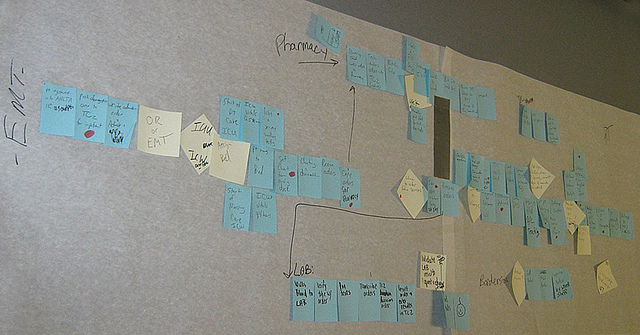The implementation of a six sigma programme depends upon many variables including, but not limited to, the size of the company, the industry in which the company operates and the resources that the company has at its disposal. Therefore, it is not possible to create a “one-size-fits-all” model for successful implementation.
However, from the literature that has been published on the subject (ANTONY et al., 2002; SANDHOLM & SORQVIST, 2002; GOLDSTEIN, 2001), a common theme becomes apparent; there are certain key factors that improve the chances of a successful programme launch. Although some of these factors are evident in earlier quality initiatives, some are new to six sigma and are the reason it is succeeding where previous movements failed:
“Six Sigma is revealing a potential for success that goes beyond the levels of improvement achieved through the many TQM efforts.”
~ (PANDE et al., 2000)
Each factor will now be considered in turn.
Critical Success Factors
- Implementing from the top, down
- Managing cultural change
- Focus on the voice of the customer
- Focus on the voice of the business
- Organisational infrastructure
- Investing in training
- Understanding six sigma techniques
- Project selection
- Linking six sigma to human resources
- Information technology (IT) infrastructure
- Innovative thinking
Critical Success Factor 1 - Implementing from the top, down
Throughout the literature on six sigma, the most widely cited success factor is top-down support or management commitment. Lack of this factor is also cited as one of the major reasons for the demise of TQM (DALE et al., 1998; HRADESKY, 1995).
The reason for the importance of management commitment is that six sigma involves changing an organisation’s culture and this in turn requires a large investment of time and resources. Therefore, it is essential that the highest levels of senior management are on board and prepared to lead the way. A visible push by upper management to dedicate resources to six sigma will show that it is the new way in which things are to be done and not just a flavour of the month fad.
“With active, consistent, innovative, continuous and widely apparent participation by top management, much can be achieved from programs like six sigma. Without such involvement, even the best of programs cannot be effective in reaching full potential.”
~ (CAPLAN, 2002)
“The top executive must be part of Six Sigma. [He or she] must change the agenda of upper management meetings so the quality initiative is right near the top.”
~ (HENDERSON & EVANS, 2000)
Indeed, this is what happened at Motorola under the direction of CEO Bob Galvin back in the 1980s when their six sigma approach was taking shape:
“Among the many things Bob did was reset the agendas for all the business unit staff meetings he attended. Rather than letting the quality subject remain in its historical position of last on the agenda (and frequently eliminated because of time constraints), he decreed quality was now always to be first. After that point in the discussion, Bob would leave the meeting.”
~ (CAPLAN, 2002)
There is a need for leaders to be strong advocates of six sigma. Only by displaying their passion and determination, will the rest of the employees get on board. This is important because, without the commitment of other employees, even the most determined manager is doomed to fail.
“No improvement process would be successful without dedicated people.”
~ (POIRIER & TOKARZ, 1996)
Perhaps the most notable proponent of six sigma is Jack Welch, CEO of General Electric. As mentioned previously, GE has enjoyed phenomenal success as a result of implementing six sigma on a company-wide basis. However, it is the enthusiasm and drive of Jack Welch that is most often quoted as being the reason for their success:
“Jack Welch…is almost unanimously heralded as the modern role model for excellence in business leadership”
~ (WATSON, 2001)
“It is no surprise that upper management has been and is the secret to success at GE…It is through Welch’s usual zeal, personal leadership, and direction that quality was and continues to be the key to success and a priority in every function.”
~ (HENDERSON & EVANS, 2000)
Critical Success Factor 2 - Managing Cultural Change
The second factor that is critical to the success of six sigma implementation is the ability to manage cultural change. This depends to a large extent on the previous factor; cultural change cannot happen without the backing of the senior executives.
Organisational culture can be considered to consist of three layers: values, beliefs and taken-for-granted assumptions (SCHEIN, 1985). Values are statements about the company’s objectives and strategies. Beliefs are more specific and are usually an opinion about something the company should or should not do, such as not using sweatshops. Taken-for-granted assumptions are the heart of an organisation’s culture. They are often difficult to voice but are evident in the way the company conducts itself (JOHNSON & SCHOLES, 1997) and can be a source of sustainable competitive advantage (BARNEY, 1986).
“Six sigma is really a cultural thing – a way of behaviour”
~ (PANDE et al., 2000)
The importance of having the right culture is emphasised by the definitions that some of the most successful six sigma companies use:
“Six Sigma is a vision we strive toward and a philosophy that is part of our business culture.”
~ (GENERAL ELECTRIC COMPANY, 2007)
Motorola uses the following description:
“Six Sigma is a business philosophy of driving behaviour by making an organisation’s values explicit in its compensation system and a business strategy of cutting costs and boosting customer satisfaction.”
~ (SITNIKOV, 2002)
Six sigma requires a change in the mindset of a company’s employees to one that is more data-driven, decisive and customer-focused. Employees that are used to working in service roles are required to learn the ability to view things from a process perspective. It is also necessary to break down traditional departmental boundaries and get used to working as cross-functional teams with the common goal of providing value to the customer. The advantage of which is:
“that it fosters a culture whereby the ownership of quality is viewed as the responsibility of the entire organisation and not just of the quality department.”
~ (HOERL, 1998)
Critical Success Factor 3 - Focus on the Voice of the Customer
The third factor affecting the success of a six sigma implementation effort is the degree to which the company focuses on the customer.
“If a six sigma program is to have the maximum effect, improvement activities need to be given a distinct customer focus. This means the selection of six sigma projects must, to a considerable extent, be based on what customer benefit is attainable.”
~ (SANDHOLM & SORQVIST, 2002)
A six sigma organisation will install a rigorous data collection system to extract the VOC. The data will then be analysed and used to prioritise requirements and as the basis for company strategies. The company will also acknowledge that customer requirements are dynamic, and will prioritise its activities to suit the emerging needs expressed by customers. Focusing on the customer will ensure that traditionally desirable measures such as increased sales and reduced costs follow:
As Jack Welch explains it – “One thing we have discovered with certainty is that anything we do that makes the customer more successful inevitably results in a financial return for us.”
~ (PANDE et al., 2000)
Critical Success Factor 4 - Focus on the Voice of the Business
Although it is critical that organisation’s focus on the VOC, it is equally important that they do not lose sight of the reason they are in business in the first place, to make profits.
“Corporate profitability must be the driver of such an effort. If it doesn’t deliver dollars to the bottom line, don’t do it.”
~ (HENDRICKS & KELBAUGH, 1998)
One of the project selection criteria, therefore, needs to be how much impact the project will have on the objectives of the organisation (INGLE & ROE, 2001). Six sigma efforts can make a business more profitable by reducing variation. This in turn leads to reduced scrap and rework rates and increased productivity. Every project should clearly state the business need on its charter. This will include the cost of doing the project (implementing solutions) and the cost of not doing it (cost of poor quality).
“Senior management speaks the language of money…learning the lower defect rate saves millions of dollars a year has a real impact on senior managers. They begin to appreciate what a sound process improvement program can do for the company. In this sense, Six Sigma is truly a breakthrough strategy.”
~ (VINING, 2003)
Critical Success Factor 5 – Organisational Infrastructure
It was mentioned previously that top-level support for six sigma is crucial, but that the senior managers rely on a team of dedicated staff to support them. Indeed, this is the case, as the majority of projects carried out in a six sigma organisation are done by teams.
Team working is a central theme in the six sigma philosophy and a number of the tools in the toolbox revolve around making teams work more efficiently. This is critical as six sigma uses cross-functional teams that will not be used to working together. A good project leader is therefore also essential.
“Teams are an integral part of successful six sigma implementation. Each milestone on the quality journey involves teams and dedicated employees who are focused on developing best practices.”
~ (COOPER & NOONAN, 2003)
Although a number of the team members will be brought in to work on a six sigma project on a part-time basis, another success factor in implementing six sigma successfully is the use of dedicated personnel. These are roles created in the organisation that spend one-hundred percent of their time carrying out the work of six sigma.
In many companies, a martial-arts style belt convention has been adopted to distinguish between the various roles.
The sponsor is the senior manager who leads the six sigma programme in the company.
The champion is a manager who backs individual six sigma projects within the organisation. Their responsibilities include securing resources and resolving cross-functional issues.
The master black belt is a highly successful black belt who is an expert in six sigma tools and techniques. His/her responsibilities include training & mentoring black belts and helping champions with project selection. There is usually one master black belt for every ten black belts in a company.
The black belt is the project leader. They work on six sigma projects full-time, usually completing between five and seven projects per year. It is also common for black belt positions to only last for two or three years, as they often get recruited into key managerial positions within the company.
The role of a green belt is to support black belts or to lead small-scale projects of their own. They have received a small amount of formal training, but only work on six sigma projects on a part-time basis.
The rest of the team is made up of yellow belts. These are employees that have an awareness of six sigma, but no formal training. They are selected to utilise their superior knowledge of the process and include team leaders and operators from the process.
“These champions of change determine the best tactics and methods to improve work functions by encouraging collaboration and cooperation. It is the interaction among these employees in their quest for excellence that makes the difference.”
~ (COOPER & NOONAN, 2003)
Critical Success Factor 6 – Investing in Training
Another factor that has been cited in the literature as an area where six sigma is more successful than earlier initiatives is training:
“TQM training tended to be dry, uninspiring and irrelevant to people’s everyday jobs. It also left people with an awareness-level understanding of concepts and tools, but without the depth of knowledge to actually use them.”
~ (PANDE et al., 2000)
It is, therefore, important that training is relevant to the employee’s everyday job. Six sigma training typically combines classroom-based theory work with on the job project work. Black Belt training, for instance, is often spread out with an intensive week in a classroom once a month for four months, with the three-week interludes spent applying what they have learned to a business related project.
“Training – both at the outset and on a sustained basis – is a key ingredient to achieving success.”
~ (PANDE et al., 2000)
Six sigma companies are well documented for having invested substantial resources into training. Such an investment could be considered a deterrent for companies considering implementing six sigma. However, the companies that have made the required level of investment have made up for it in improved business results.
“The companies that have produced good results have invested adequate resources, provided extensive training programs and involved many individuals in their Six Sigma programs.”
~ (SANDHOLM & SORQVIST, 2002)
Critical Success Factor 7 – Understanding Six Sigma Techniques

In a previous series of blog posts, the various tools that make up the six sigma toolbox were introduced. These tools have been collated from a number of different disciplines including, project management, statistics, change management, team working and lean manufacturing. It is, therefore, unlikely that any individual will be familiar with all of them, which is where training again plays an important role.
It is essential that the black belts have an in-depth knowledge of the tools available to them so that they can elect to use the right one, at the right time for the right task. It is also important that they understand the limitation of each technique and do not get carried away with using tools for the sake of it. This is where the role of master black belt as a mentor is useful, as they can guide black belts through difficult analyses.
“Each tool and technique within the six sigma methodology has a role to play and when, where, why and how these tools or techniques should be applied is the difference between success and failure of a six sigma project.”
~ (ANTONY et al., 2006)
It is also important for green belts and managers to have a working knowledge of the tools so that they can understand, and follow along with the progress of the project.
Critical Success Factor 8 – Project Selection
Project selection is also a critical factor in determining the success of a six sigma implementation effort:
“Project selection [is] the most critical and most commonly mishandled activity in launching Six Sigma. Its a pretty simple equation, really: Well-selected and defined improvement projects equal better, faster results. The converse is also simple: Poorly selected and defined projects equal delayed results and frustration.”
~ (PANDE et al., 2000)
“A critical step at GE is identifying and bounding Six Sigma projects…Projects are selected based on their ability to impact either customer satisfaction or business priorities. In addition, projects may be selected to leverage successfully completed projects to other processes, sites, or product lines.”
~ (HENDERSON & EVANS, 2000)
Therefore in order for project selection to be carried out effectively, an understanding of what makes a good six sigma project is required. According to Goldstein (2001), a good six sigma project will observe the following 6 points:
- Focus on the customer. A good project will make a noticeable difference to the customer whether they are internal or external. It is also important to realise that for some defects the cost of failure can be more important than frequency of occurrence. For example, an aircraft wing failure may have minimal occurrence, but would be very costly to the business. It would obviously make an excellent project as the customer would benefit directly.
- The response variable can be easily measured.
- There should be a financial benefit to the business. A good project will have a definitive answer to these questions:
- What impact is experienced by the business as a result of the problem?
- What cost results from that problem?
- Data can be easily collected.
- The project has a high probability of success. If there is no chance of the project succeeding then it would be better to allocate the resources where they will have more benefit.
- The project can be completed in four to six months. It is critical that projects be completed in this time frame in order to keep the organisation and resources focused on the project (GATES, 1999).
Once the defining characteristics of a good six sigma project are understood, it is possible to set up a process to identify project candidates. The correct approach will make use of existing systems and data sources within the company such as:
- Existing company information
- Competitor benchmarking
- Customer complaints
- Feedback from customer service or sales reps
- Interviews, surveys and focus groups
Project managers should be assigned rather than being allowed to select which project to work on as this can lead to opportunities being missed or inappropriate projects being started. Project selection is a task for upper management:
“Getting upper management Champions involved in the project selection process helps guarantee the projects will have a large impact on the business.”
~ (LUCAS, 2002)
Critical Success Factor 9 – Linking Six Sigma to Human Resources
The Human Resource Management (HRM) department has numerous roles to play within a six sigma organisation. How well they carry them out is another determining factor in how successful the programme will be. For instance recruiting the right candidates for the roles of black belt and master black belt is essential. The training of such candidates is usually a human resources function as well. It will also be the responsibility of HRM to retain black belts after they complete their two to three-year placement by finding them alternative positions within the company. This ensures that the investment in training is not wasted.
Motivating employees throughout the cultural change and introduction of a six sigma programme is also an essential task. Neglecting to do this can result in resentment and resistance to change, ultimately endangering the overall success of the six sigma programme. For this reason, it is common for organisations to introduce various reward schemes to aid motivation and focus:
“Salary increments and possible bonus systems should be closely linked to the company’s six sigma program.”
~ (SANDHOLM & SORQVIST, 2002)
At General Electric, for example, “forty percent of every manager’s bonus is tied to his or her progress on quality results [as] determined by customer surveys”
~ (COHEN, 1997).
Critical Success Factor 10 – Information Technology (IT) Infrastructure
In a previous post, a number of definitions of six sigma were considered, including that of Harry & Schroeder (2000). Not only does six sigma require “rigorous data gathering and statistical analysis”, but also dissemination of lessons learned, as was discussed in the explanation of the control phase. These were highlighted by Kendall & Fulenwider (2000) as the key activities that require support from an IT infrastructure. An efficient infrastructure will improve the data collection process, or in some cases automate it. It also provides an efficient means of sharing the gathered data between all interested parties.
“The systems have to give you data instantaneously…the IT infrastructure could make or break the Six Sigma effort.”
~ (PAUL, 1999)
The IT infrastructure can also be used to support other critical success factors such as training. This can include the use of web-based learning modules to provide a cheap and efficient alternative to sending staff on external courses. Motorola created Motorola University, which began as an internal programme offering courses to employees on a range of business-related topics. However, with the proliferation of six sigma they began to offer their training at a cost to external companies.
Finally, an IT infrastructure can be used to manage six sigma projects on a global scale. A project tracking database is used to monitor the progress of current projects, display results of completed projects and list black belts available for allocation to new projects. It is also possible to search the database for similar situations so that lessons learned may be transferred directly, saving both time and money.
Critical Success Factor 11 – Innovative Thinking
The improvement required to move from a three or four sigma company, up to a six sigma, world-class one is considerable. In order to make that jump in a realistic timeframe, the impact each project makes must be maximised. Therefore, innovative rather than incremental solutions are the key to competitiveness.
“Technical challenges and a harsh competitive environment make innovation mandatory.”
~ (VERDUYN, 2002)
Incremental improvement was a cornerstone of the TQM approach. Ultimately, though, it led to frustration amongst managers as results failed to filter through to the company’s bottom line:
“Concepts of incremental improvement must be discouraged because they lead to mediocre solutions and prevent people from realising the full potential of the initiative.”
~ (GUPTA, 2005)
This drive for creative problem-solving has led to the combination of six sigma with TRIZ. TRIZ is a Russian acronym that translates as Theory of Inventive Problem Solving and was founded by Genrich Altshuller after World War II. It is a method of quickly and efficiently arriving at breakthrough concepts:
“With TRIZ, an engineer’s knowledge, creativity and problem-solving skills, for generating inventive solutions to difficult problems, is significantly enhanced.”
~ (BLOSIU & KOWALICK, 1996)
The advantage of adopting both methods is that it combines the innovative approach of TRIZ with the structured analytical approach of six sigma:
“By combining these two independently successful and revolutionary methodologies into a single, co-ordinated process, the aim has been to establish a systematic and integrated process for creating superior high-performance products and services.”
~ (ANONYMOUS, 2002a)
References
- ANONYMOUS. (2002a). Going Beyond Six Sigma Design. Strategic Direction. Vol. 18. No. 9. pp. 32-34.
- ANTONY, J. BAÑUELAS, R. & KNOWLES, G. (2002). Implementing Six Sigma. Manufacturing Engineer. Vol. 81. No. 4. pp. 181-185.
- ANTONY, J. BAÑUELAS, R. & KUMAR, A. (2006). World Class Applications of Six Sigma – Real World Examples of Success. Oxford: Butterworth-Heinemann Ltd.
- BARNEY, J. B. (1986). Organizational Culture: Can It Be a Source of Sustained Competitive Advantage? The Academy of Management Review. Vol. 11. No. 3. pp. 656-665.
- BLOSIU, J. & KOWALICK, J. (1996). TRIZ and Business Survival. The TRIZ Journal [Online]. November 1996 Issue.
- CAPLAN, F. (2002). Six Sigma Success Must Begin at the Top. ASQ Six Sigma Forum Magazine. Vol. 2. No. 1. p 8.
- COHEN, A. (1997). General Electric. Sales and Marketing Management. Vol. 149. No. 11. p 57.
- COOPER, N. P. & NOONAN, P. (2003). Do Teams and Six Sigma Go Together? Quality Progress. Vol. 36. No. 6. pp. 25-28.
- DALE, B. VAN DER WIELE, T. WILLIAMS, R. & GREATBANKS, R. (1998). TQM: The Challenges for European Business. Quality World. July 1998 Issue. pp. 46-49.
- GATES III, W. H. (1999). Business @ The Speed of Thought. New York: Warner Books.
- GENERAL ELECTRIC COMPANY. (2007). What Is Six Sigma? The Roadmap to Customer Impact [Online]. Available from: www.ge.com/sixsigma/SixSigma.pdf. Accessed on: 11th April 2007. Fairfield: General Electric Company.
- GOLDSTEIN, M. (2001). Six Sigma Program Success Factors. ASQ Six Sigma Forum Magazine. Vol. 1. No. 1. pp. 36-45.
- GUPTA, P. (2005). Innovation: The Key to a Successful Project. ASQ Six Sigma Forum Magazine. Vol. 4. No. 4. pp. 13-17.
- HARRY, M. & SCHROEDER, R. (2000). Six Sigma: The Breakthrough Management Strategy Revolutionizing the World’s Top Corporations. New York: Doubleday.
- HENDERSON, K. & EVANS, J. (2000). Successful Implementation of Six Sigma: Benchmarking General Electric Company. Benchmarking. Vol. 7. No. 4. pp. 260-281.
- HENDRICKS, C. A. & KELBAUGH, R. (1998). Implementing Six Sigma at GE. The Journal of Quality and Participation. Vol. 21. No. 4. pp. 48-53.
- HOERL, R. (1998). Six Sigma and the Future of the Quality Profession. Quality Progress. Vol. 31. No. 6. pp. 35-42.
- HRADESKY, J. S. (1995). Total Quality Management Handbook. New York: McGraw Hill.
- JOHNSON, G. & SCHOLES, K. (1997). Exploring Corporate Strategy 4th Edition. Hemel Hempstead: Prentice Hall.
- KENDALL, J. & FULENWIDER, D. (2000). Six Sigma, E-Commerce Pose New Challenges. Quality Progress. Vol. 33. No. 7. pp. 31-37.
- LUCAS, J. M. (2002). The Essential Six Sigma. Quality Progress. Vol. 35. No. 1. pp. 27-31.
- PANDE, P. NEUMAN, R. & CAVANAGH, R. (2000). The Six Sigma Way – How GE, Motorola, and Other Top Companies Are Honing Their Performance. New York: McGraw Hill.
- PAUL, L. (1999). Practice Makes Perfect. CIO Enterprise. Vol. 12. No. 7. Section 2. pp. 24-29.
- POIRIER, C. C. & TOKARZ, S. J. (1996). Avoiding the Pitfalls of Total Quality. Milwaukee: ASQC Quality Press.
- SANDHOLM, L. & SORQVIST, L. (2002). 12 Requirements For Six Sigma Success. ASQ Six Sigma Forum Magazine. Vol. 2. No. 1. pp. 17-22.
- SCHEIN, E. (1985). Organisation Culture and Leadership. San Francisco: Jossey-Bass.
- SITNIKOV, C. (2002). The “Six Sigma Phenomena” – Old or New Perception of Quality? Publication Series of the Institute for Regional Economics and Business Strategy. April 2002.
- VERDUYN, D. (2002). Integrating Innovation Into Design For Six Sigma. The TRIZ Journal [Online]. February 2002 Issue.
- VINING, G. G. (2003). A Personal Perspective on Six Sigma. ASQ Six Sigma Forum Magazine. Vol. 2. No. 4. p 8.
- WATSON, G. H. (2001). Cycles of Learning: Observations of Jack Welch. ASQ Six Sigma Forum Magazine. Vol. 1. No. 1. pp. 13-17.








